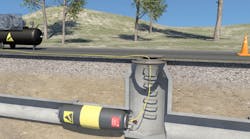Latest from Plumbing
Sponsored
When using a pipe plug, you are doing one of three things:
(1) stopping the flow in a pipeline or opening;
(2) bypassing the flow running through the pipeline, or
(3) performing a low-pressure air test on a new pipeline before placing it into service; or testing a pipeline already in service for leaks.
There are two pipe plug options to choose from.
● Mechanical plugs (ranging from .39 inches to 18 inches) are used for long-term or permanent plumbing applications.
● Pneumatic plugs (ranging from 1 inch to 96 inches) are used for short-term waterworks applications. (If a pneumatic plug is needed for a longer period, the inflation pressure must be checked every four hours and adjusted as required.)
Whether you are using a plug for testing, maintenance, or repair, it’s important to use a high-quality product you can rely on. Let's take a further look at the two options and how to use them safely:
Mechanical Pipe Plugs
How they work: Mechanical pipe plugs allow you to section off part of the pipe, so that you can work or test the section without shutting off the rest of the system. Mechanical plugs do not need to be inflated and are expanded to fit tightly within a pipe or open mechanically.
Most only require to be hand-tightened, but they can also be tightened and locked in place with a bolt or wing nut, which provides a leak-tight seal within the pipe. Once the plug is in place, you can pressurize the system with air or water to detect any problems.
Benefits: Mechanical pipe plugs are smaller, lighter-weight, and don't require air to inflate or seal. They expand to fit tightly within a pipe or can be opened mechanically by hand. They do not deflate over time like inflatable plugs, making them better for long-term applications or pipes with a higher pressure requirement.
Types: There are a couple of options when it comes to the different types of mechanical plugs—
● Blocking plugs are used to test DWV systems. They fit into pipe diameters up to 6 inches and are sealed for testing.
● Bypass plugs are for the installation and repair of residential or commercial piping systems. Used when a system repair is needed while wastewater must continue to flow, they allow both testing and monitoring for pipes up to 18 inches.
Some mechanical plug options offer specialized features, such as chemical resistance, the ability to lock in place, or are designed for specific applications, such as Pipe Hubs and Clean Out Coverings.
Pneumatic Pipe Plugs
Uses: Pneumatic pipe plugs are also used for blocking, bypassing, or air testing. Mainly used when working with industrial underground waterworks systems, they can fit into pipes up to 120 inches in diameter. They can also be used in smaller plumbing applications to test a complete system for leaks.
How they work: A pneumatic plug is a rubber ball that can be inflated with air, water, or any inert gas (nitrogen) with a bicycle pump or large air compressor. As it fills with air, it expands against the pipe and seals in place, either stopping the flow in the pipe or redirecting it to go somewhere else. A second test ball must be put in place to check for any leaks between the two to run a low-pressure air test.
Types: There are a couple of options when it comes to the different types of pneumatic plugs—
● Blocking/test ball plugs are used for blocking the flow during maintenance in sanitary or sewer systems. They can also be used as back plugs for sewer air tests. A test ball doesn't have a bypass and is designed to do one job, blocking (sealing) a pipe.
● Bypass/muni ball plugs are used for testing and monitoring pipe systems. Some bypass plugs are designed to handle high back pressure in applications such as water mains, force mains, and industrial lines. A Muni Ball has a bypass tube running through the plug that allows the user to bypass effluent through the tube. With an adapter cap, it can be converted to complete an air test. Muni Balls can also be used for blocking pipes.
Safety Reminders
Users must review the safety manual for complete operation and safety instructions before using the equipment.
● Always be aware of the Danger Zone: Never enter the Danger Zone while a plug is in use. A danger zone area expands outwardly in a cone shape from where the plug is. The total force exerted on a pipeline plug is directly proportional to both the pressure and the pipeline area. The amount of force behind a plug can be overwhelming.
● Prep before using plugs: Make sure to select the correct plug size for the application, check the maximum back pressure so you do not exceed it, and use a calibrated gauge. Be sure to properly inspect the pipe and plug of any debris or foreign substances before use. A plug should not be used if it shows any sign of wear or deterioration.
● Monitor placement and pressure of plugs: Never over or under-inflate the plug. Position the plug into the pipe at a distance at least equal to the pipe diameter and use the correct media while inflating. Always release the back pressure from the pipe before deflating to avoid dislodging the plug.
● Maintain proper maintenance and storage: Plugs may be cleaned with mild soap and water and stored in a dry place away from sunlight. Inspect the plug for damage (any signs of cut, wear or deterioration) after each use. If damaged, do not use it again.
Following these simple steps and taking the time to correctly do the procedure can actually make the difference between life and death. Cherne provides safety tags and safety instruction manuals with each plug that leaves our factory. Ensure that you and everyone on your crew are familiar with the hazards and the preventive measures necessary when working with pipe plugs.
Jake Shevik is a Product Manager at Cherne. He can be reached at [email protected].



